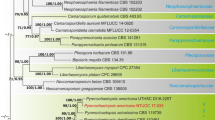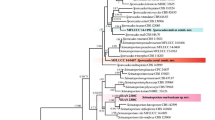Abstract
Mycochaetophora gentianae, the causal agent of brown leaf spot on gentian (Gentiana scabra), is characterized by its hyaline besom-like sporophore, although its conidiogenesis and phylogenetic position have so far remained unknown. We isolated the causal fungus from a new host, G. triflora, in Iwate, Japan. Both the G. triflora isolate and the ex-type M. gentianae isolate produced symptoms on G. triflora but not on G. scabra. Microscopic observations of the diseased leaves indicated that conidiogenesis was blastic from short conidiophores, and schizolytic secession of conidia left unthickened and inconspicuous conidial scars on the conidiogenous cells. Conidia were catenate, in branched acropetalous chains; secondary conidia were blastically produced from the first or second cell at the base of primary conidium. The G. triflora isolate was identified as M. gentianae because of its identity to the ex-type in characteristics of culture, pathogenicity, and conidia. Phylogenetic analyses using three ribosomal DNA (rDNA) sequences combined [small subunit (SSU) + large subunit (LSU) + 5.8S rDNA] indicated that both isolates clustered with Rhexocercosporidium carotae, and the cluster was placed within Helotiales–Rhytismatales. Additional analyses using internal transcribed spacers including 5.8S rDNA sequences revealed that both isolates were monophyletic and that they were closely related to three helotialean Pseudocercosporella-like hyphomycetous genera: Helgardia, Rhexocercosporidium and Rhynchosporium.




Similar content being viewed by others
References
Arenz BE, Held BW, Jurgens JA, Farrell RL, Blanchette RA (2006) Fungal diversity in soil and historic wood from the Rosses Sea Region of Antarctica. Soil Biol Biochem 38:3057–3064
Årsvoll K (1965) Acrothecium carotae n. sp., a new pathogen on Daucus carota L. Acta Agric Scand 15:101–114
Braun U (1994) Miscellaneous notes on phytopathogenic hyphomycetes. Mycotaxon 51:37–68
Braun U (1995) A monograph of Cercosporella, Ramularia and allied genera (phytopathogenic hyphomycetes), vol 1. IHW Verlag, Eching
Braun U (1998) A monograph of Cercosporella, Ramularia and allied genera (phytopathogenic hyphomycetes), vol 2. IHW Verlag, Eching
Caldwell RM (1937) Rhynchosporium scald of barley, rye, and other grasses. J Agric Res 55:175–198
Crous PW, Groenewald JZ, Gams W (2003) Eyespot of cereals revisited: ITS phylogeny reveals new species relationships. Eur J Plant Pathol 109:841–850
Crous PW, Braun U, Schubert K, Groenewald JZ (2007) Delimiting Cladosporium from morphologically similar genera. Stud Mycol 58:33–56
Deighton FC (1973) Studies on Cercospora and allied genera. IV. Cercosporella Sacc., Pseudocercosporella gen. nov. and Pseudocercosporidium gen. nov. Mycol Pap 133:1–62
Fernando AA, Currah RS (1995) Leptodontidium orchidicola (Mycelium radicis atrovirens complex): aspects of its conidiogenesis and ecology. Mycotaxon 54:287–294
Fitt BDL, Goulds A, Polley RW (1988) Eyespot (Pseudocercosporella herpotrichoides) epidemiology in relation to prediction of disease severity and yield loss in winter wheat—a review. Plant Pathol 37:311–328
Gilles T, Fitt BDL, Kennedy R, Welham SJ, Jeger MJ (2000) Effects of temperature and wetness duration on conidial infection, latent period and asexual sporulation of Pyrenopeziza brassicae on leaves of oilseed rape. Plant Pathol 49:498–508
Goodwin SB (2002) The barley scald pathogen Rhynchosporium secalis is closely related to the discomycetes Tapesia and Pyrenopeziza. Mycol Res 106:645–654
Goodwin SB, Dunkle LD, Zismann VL (2001) Phylogenetic analysis of Cercospora and Mycosphaerella based on the internal transcribed spacer region of ribosomal DNA. Phytopathology 91:648–658
Gray LE, Grau CR (1999) Brown stem rot. In: Hartman GL, Sinclair JB, Rupe JC (eds) Compendium of soybean diseases, 4th edn. The American Phytopathological Society, St. Paul, pp 28–29
Hara K (1931) Materials for the fungus-flora of Nippon 3. Fungi 1:103–113 (in Japanese)
Harrington TC, Mcnew DL (2003) Phylogenetic analysis places the Phialophora-like anamorph genus Cadophora in the Helotiales. Mycotaxon 87:141–151
Held BW, Jurgens JA, Duncan SM, Farrell RL, Blanchette RA (2005) Assessment of fungal diversity and deterioration in a wooden structure at New Harbor, Antarctica. Polar Biol 29:526–531
Horikoshi N, Ono M, Tairako K (2003) Screening of effective fungicides and optimum timing for the control of disease, Kappan-byo, of gentian caused by Thallosporiella gentianae. Jpn J Phytopathol 69:292–293 (in Japanese)
Kageyama SA, Mandyam, Jumpponen A (2008) Diversity, function and potential applications of the root-associated endophytes. Springer, Berlin, pp 29–57
Kastelein P, Stilma ESC, Elderson J, Köhl J (2007) Occurrence of Rhexocercosporidium carotae on cold stored carrot roots in the Netherlands. Eur J Plant Pathol 117:293–305
Kasuyama S, Idei T (1987) Prediction for occurrences of brown leaf spot of hydrangea and gentian for cut flower (new disease) in Okayama prefecture, Japan. Ann Phytopathol Soc Jpn 53:377–378 (in Japanese)
Kirk PM, Cannon PF, Minter DW, Stalpers JA (2008) Dictionary of the fungi, 10th edn. CAB International, Wallingford
Kobayashi T, Kasuyama S, Nasu H, Ono Y, Watanabe K (2009) Brown leaf spot disease of gentian, Gentiana scabra var. buergeri (Miq.) Maxim. and its causal fungus. Jpn J Phytopathol 75:1–8 (in Japanese)
Lumbsch HT, Huhndorf SM (eds) (2007a) Outline of ascomycota—2007. Myconet 13:1–58
Lumbsch HT, Huhndorf SM (eds) (2007b) Notes on ascomycete systematics. Nos 4408–4750. Myconet 13:59–99
Nakatani F, Takahashi S (1991) Occurrence and control of disease, Kappan-byo, of gentian caused by Thallosporiella gentianae Yokoyama et Kasuyama. Ann Rep Plant Prot North Jpn 42:66–68 (in Japanese)
Reelder RD (2007) Rhexocercosporidium panacis sp. nov., a new anamorphic species causing rusted root of ginseng (Panax quinquefolius). Mycologia 99:91–98
Rehner SA, Samuels GJ (1994) Taxonomy and phylogeny of Gliocladium analysed from nuclear large subunit ribosomal DNA sequences. Mycol Res 98:625–634
Robbertse B, Campbell GF, Crous PW (1995) Revision of Pseudocercosporella-like species causing eyespot disease of wheat. S Afr J Bot 61:43–48
Shoemaker RA, Hambleton S, Lacroix M, Tesolin M, Coulombe J (2002) Fungi Canadenses No 344 in: Rhexocercosporidium carotae. Can J Plant Pathol 24:359–362
Tamura K, Dudley J, Nei M, Kumar S (2007) MEGA4: molecular evolutionary genetics analysis (MEGA) software version 4.0. Mol Biol Evol 24:1596–1599
Thompson JD, Higgins DG, Gibson TJ (1994) ClustalW: improving the sensitivity of progressive multiple sequence alignment through sequence weighting, position-specific gap penalties and weight matrix choice. Nucl Acids Res 22:4673–4680
Wang Z, Binder M, Schoch CL, Johnston PR, Spatafora JW, Hibbett DS (2006a) Evolution of helotialean fungi (Leotiomycetes, Pezizomycotina): a nuclear rDNA phylogeny. Mol Phylogenet Evol 41:295–312
Wang Z, Johnston PR, Takamatsu S, Spatafora JW, Hibbett DS (2006b) Toward a phylogenetic classification of the Leotiomycetes based on rDNA data. Mycologia 98:1065–1075
White TJ, Brun TLS, Taylor JW (1990) Amplification and direct sequencing of fungal ribosomal RNA genes for phylogenetics. In: Innis MA, Gelfand DH, Sninsky JJ, White TJ (eds) PCR protocols: a guide to methods and applications. Academic, New York, pp 315–322
Wu L, Guo S (2008) Interaction between an isolate of dark-septate fungi and its host plant Saussurea involucrata. Mycorrhiza 18:79–85
Yonezawa N, Kawano S (1989) Variations in Japanese Gentiana Sect. Pneumonanthe (Gentianaceae) with special reference to their taxonomic status. Acta Phytotax Geobot 40:13–30 (in Japanese)
Yoshiike T (1992) Foundation of cultivation. In: Yoshiike T (ed) Rindou: Ikusyu to Saibai (breeding and cultivation of gentian). Seibundoshinkosha, Tokyo, pp 68–72 (in Japanese)
Acknowledgments
The authors gratefully acknowledge Dr. Kappei Kobayashi (Iwate Biotechnology Research Center) for sequencing our PCR products and Dr. Naoyuki Matsumoto (National Agricultural Research Center for Hokkaido Region) for critically reading the manuscript.
Author information
Authors and Affiliations
Corresponding author
About this article
Cite this article
Nekoduka, S., Tanaka, K., Harada, Y. et al. Phylogenetic affinity of Mycochaetophora gentianae, the causal fungus of brown leaf spot on gentian (Gentiana triflora), to Pseudocercosporella-like hyphomycetes in Helotiales. Mycoscience 51, 123–133 (2010). https://doi.org/10.1007/s10267-009-0021-3
Received:
Accepted:
Published:
Issue Date:
DOI: https://doi.org/10.1007/s10267-009-0021-3




